First Division Monument
Introduction
Text-to-speech Audio
The First Division Monument honors fallen members of the First Division of the United States Army. Located in President's Park outside the Eisenhower Executive Office Building, the monument was originally erected and dedicated in 1924 in honor of First Division members who died in World War I. The Society of the First Division, under the leadership of Major General Charles P. Summerall, advocated for a World War I monument in the nation's capital. Over the years, multiple additions to the monument honor First Division members who died in World War II, the Vietnam War, and Desert Storm. Its design reflects the Battle Monument at the United States Military Academy in West Point. It features a granite columnn and pedestal designed by Cass Gilbert and a winged statue of Victory by David Chester French. The First Division Monument is under the care of the National Park Service and hosts services on Veterans Day.
Images
The Eisenhower Executive Office Building housed the Departments of State, War, and the Navy when the First Division Monument was built. Photo by Leonard J. DeFrancisci, Wikimedia Commons (CC BY-SA 3.0)
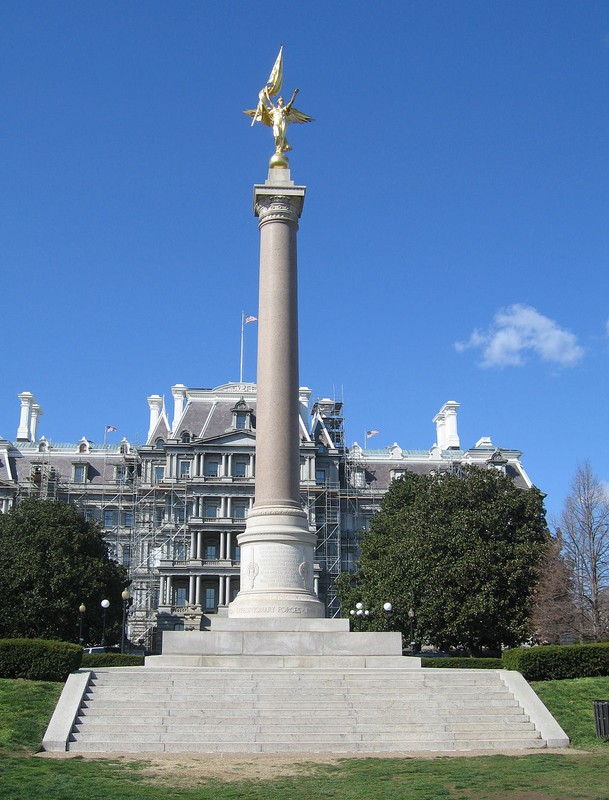
The winged statue of Victory by Daniel Chester French stands tall in President's Park. Photo by Rob Young, Wikimedia Commons (CC BY-SA 2.0).
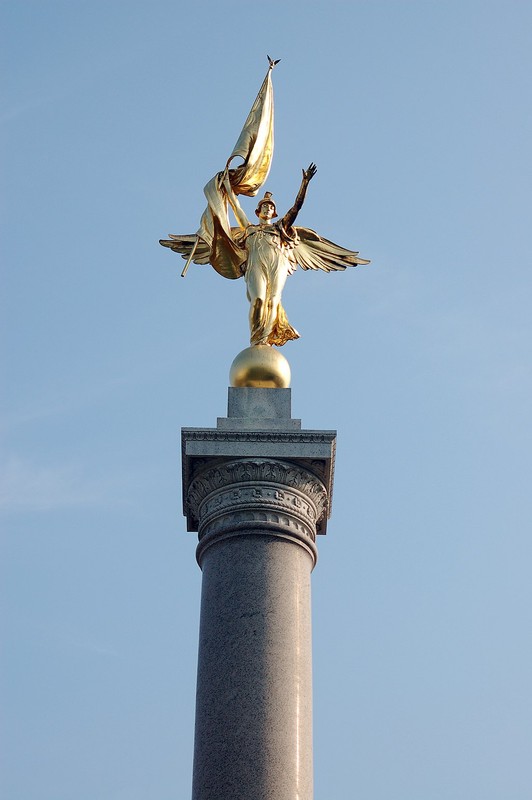
The inscription commemorates the fallen who gave their lives so "that the liberty and the ideals of our country might endure." Photo by Leonard J. DeFrancisci, Wikimedia Commons (CC BY-SA 3.0)
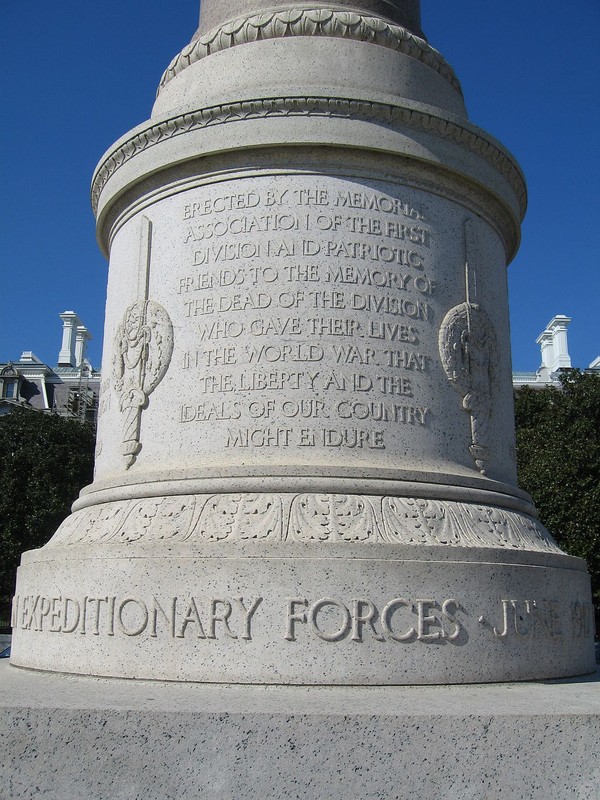
The east end of the First Division monument honoring First Division members who died in Vietnam. Photo by Leonard J. DeFrancisci, Wikimedia Commons (CC BY-SA 3.0).
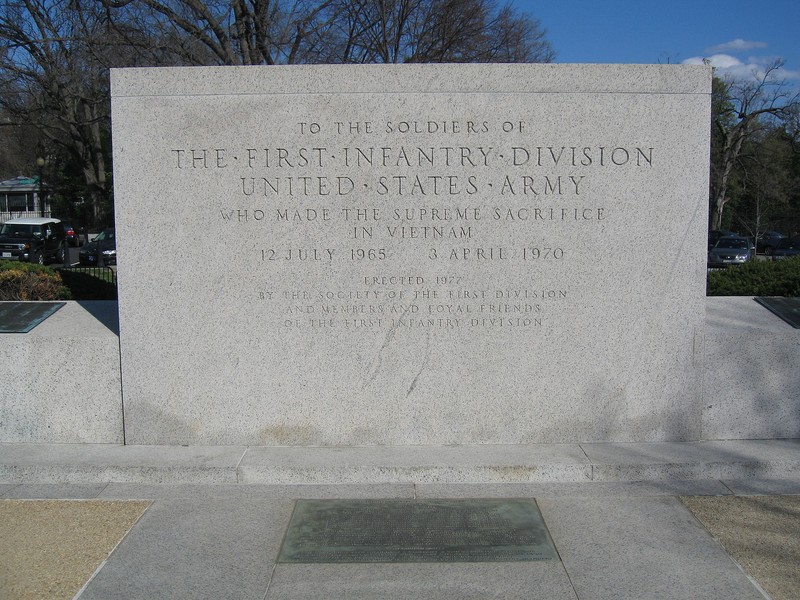
Plaque honoring First Division members who died in Desert Storm. Photo by Leonard J. DeFrancisci, Wikimedia Commons (CC BY-SA 3.0).
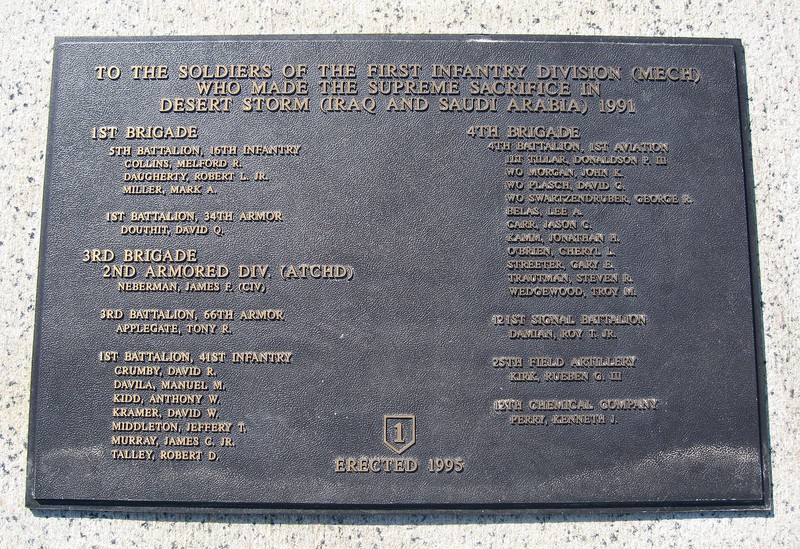
Portrait of Major General Charles P. Summerall, one of the leading visionaries of the First Division Monument. Courtesy of the United States Army (public domain).
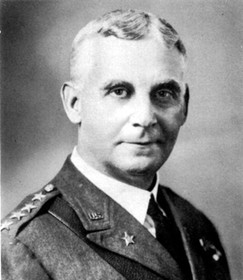
President Calvin Coolidge addresses the crowds at the First Division Monument's dedication on October 4, 1924. Courtesy of the Library of Congress (public domain).
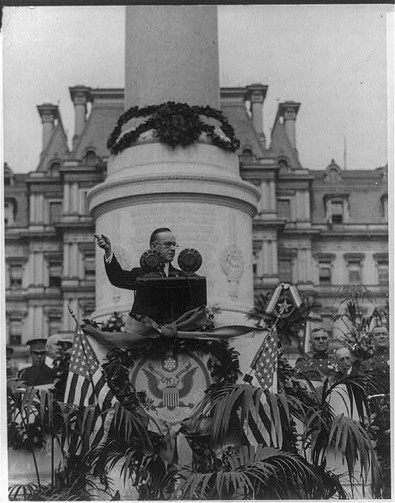
Photograph of the First Division Monument taken from what is now the Eisenhower Executive Office Building. Photo by Harris and Ewing, Library of Congress (pubic domain).
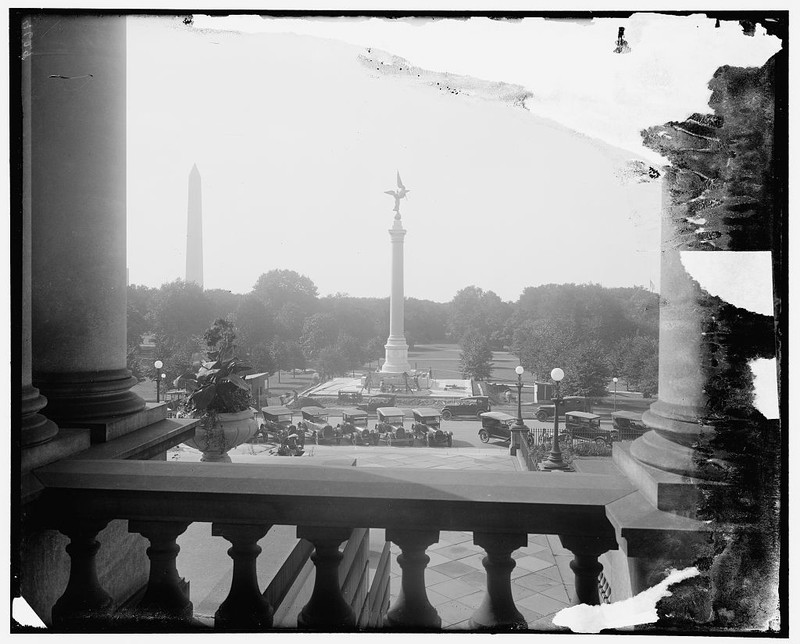
The First Infantry Division's modern combat service identification badge. Courtesy of United States Army Institute of Heraldry.
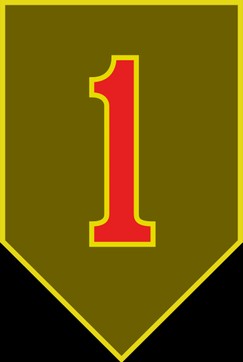
Backstory and Context
Text-to-speech Audio
The First Division was formed as part of the American Expeditionary Forces in May 1917 after the United States declared war on Germany. These forces were the first in the United States Military to fight overseas. The First Division was a particular favorite of General John J. Pershing, commander in chief of the American Expeditionary Forces, and the division earned the nickname “Pershing’s Own.” In February 1919, active soldiers in Germany came together and formed the Society of the First Division to honor the fallen.
The First Division Monument was a special project of Major General Charles P. Summerall, the president of the Society of the First Division and a commander in World War I. He proposed the memorial in September 1919, and by October, the First Division Memorial Association was organized to raise funds and manage the project. Summerall and the memorial team collaborated with the Commission of Fine Arts, an agency that oversees building design in Washington, D.C., to create a beautiful and honorable monument on federal grounds. Summerall’s vision for the monument was inspired by the Battle Monument, a Civil War memorial at the United States Military Academy in West Point, New York. It consisted of a tall granite columnn with a statue of Victory at the top. The base listed the names of fallen soldiers and officers. Summerall wanted a monument that commemorated all fallen soldiers of the First Division, unlike many of the Civil War monuments in D.C., which often displayed a notable individual on horseback.
Throughout the planning and construction processes, the First Division Monument team and the Commission of Fine Arts faced important decisions about the monument’s design and meaning. This would be the first monument to the Great War in the nation’s capital, and no war since the Civil War engaged soldiers and citizens so rigorously. The Commission of Fine Arts initially pushed for a national memorial, rather than one solely dedicated to the First Division. They realized, however, that populating D.C. with a variety of World War I monuments would create balance among the city’s numerous Civil War monuments. the First Division Memorial Association chose a site for the monument, they took such ideas into consideration. Their site fulfilled the Senate Park Commission Plan of 1901-02, which called for a monument in President’s Park outside the Eisenhower Executive Office Building, formerly known as the State, War, and Navy Building and the Old Executive Office Building. This site also created a visual balance with a nearby statue of Civil War general William Tecumseh Sherman. Yet the Commission of Fine Arts favored a fountain instead of a columnn monument on this site. The monument’s architect, Cass Gilbert, argued that a fountain would be more difficult to maintain and that columnns around the world, such as Nelson’s Column in London’s Trafalgar Square and Trajan’s Column in Rome, proved the permanence and power of this design. The Commission of Fine Arts agreed.
The Society of the First Division hired prominent figures in art and architecture to create a contemporary yet classical monument. They hired architects Cass Gilbert to build the monument and sculptor David Chester French to create the statue of Victory. Gilbert designed grand works such as the Woolworth Building in New York and Washington, D.C.’s Treasury Annex Building, U.S. Chamber of Commerce Building, and Supreme Court Building. French, a founder of the Commission of Fine Arts, fashioned the statue of Abraham Lincoln in the Lincoln Memorial and the fountain in Dupont Circle. Additionally, the monument project explored the George A. Fuler company to create the pedestal, the Dodd’s Granite Company to extract the unique and desirable Milford pink granite, and the Piccirilli Brothers and the Roman Bronze Works of New York cast the statue.
Completed in 1924, the First Division Monument stood at 78 feet, from the ground to the top of the Victory statue. It included the names of 5,599 members of the First Division on bronze plaques. French’s winged statue of Victory, an ancient Roman goddess often personified in American art. She stands in a dynamic pose with hands outstretched, a waving flag, and a flowing dress. The National Park Service calls her “an eternal flame on the constant memorial.” The First Division Monument was dedicated on October 4, 1924, with more than 6,000 veterans and guests in attendance. Major General Summerall and President Calvin Coolidge spoke and the First Division band played the “Star-Spangled Banner.”
Like the symbolic statue of Victory, the First Division Monument has been dynamic. After acquired by the National Park Service in 1939, new additions have been added to commemorate fallen First Division soldiers in subsequent wars. The World War II addition, designed by Cass Gilbert Jr., was added August 24, 1957, honoring the more than 4,300 who fought throughout Europe and North Africa. A mirroring design was completed in May 1977, to honor the more than 3,000 soldiers who died in Vietnam, where the First Division was the first to be deployed in the war. In the 1990s, the First Division led armored attacks in Desert Storm, and a plaque honoring the 27 soldiers who died was dedicated on Memorial Day in 1995. The grounds have also undergone change. In the 1960s, Lady Bird Johnson led efforts to create a flower bed in the shape of the First Division patch. Services are held at the First Division Monument on Veterans Day, while the Society of the First Infantry Division has a commemoration plan in place to guide future expansion of the monument. Constantly evolving yet steadfast, the First Division Monument is a prominent reminder of those who made the ultimate sacrifice.
Sources
“First Division Memorial.” Sculpture. Art Inventories Catalog. Smithsonian American Art Museum. Smithsonian Institution Research Information System. Accessed October 2017. https://siris-artinventories.si.edu/ipac20/ipac.jsp?session=JA180202965L3.1742&profile=ariall&source...
Goode, James M. Washington Sculpture: A Cultural History of Outdoor Sculpture in the Nation's Capital. Baltimore: Johns Hopkins University Press, 2008.
Janke, Lucinda Prout. “The President’s Park.” The White House Historical Association. Accessed October 2017. https://www.whitehousehistory.org/the-presidents-park
Library of Congress. “The American Expeditionary Forces.” Stars and Stripes: The American Soldiers' Newspaper of World War I, 1918 to 1919. Library of Congress. Accessed October 2017. https://www.loc.gov/collections/stars-and-stripes/articles-and-essays/a-world-at-war/american-expeditionary-forces/
National Park Service. “First Division Monument.” President’s Park. National Mall and Memorial Parks. Written by Silvina Fernandez-Duque. Last updated March 10, 2016. Accessed October 2017. https://www.nps.gov/whho/learn/historyculture/first-division-monument.htm
Images:
“Front view of the First Division Monument…” Photo. 2008. Leonard J. DeFrancisci. Wikimedia. Accessed October 2017. https://en.wikipedia.org/wiki/First_Division_Monument#/media/File:First_Division_Monument_Front_1.jpg
“First Division Monument.” Photo. 2011. Rob Young. Wikimedia. Accessed October 2017. https://commons.wikimedia.org/wiki/Category:First_Division_Monument#/media/File:First_Division_Monument_(5945970231).jpg
“Close-up of the base for the columnn at the First Division Monument.” Photo. 2008. Leonard J. DeFrancisci. Wikimedia. Accessed October 2017. https://commons.wikimedia.org/wiki/Category:First_Division_Monument#/media/File:First_Division_Monument_Column_Base_1.jpg
“East end of the First Division Monument.” Photo. 2008. Leonard J. DeFrancisci. Wikimedia. Accessed October 2017. https://commons.wikimedia.org/wiki/Category:First_Division_Monument#/media/File:First_Division_Monument_East_End_1.jpg
“Plaque located on the Operation Desert Storm memorial.” Photo. 2008. Leonard J. DeFrancisci. Wikimedia. Accessed October 2017. https://commons.wikimedia.org/wiki/Category:First_Division_Monument#/media/File:First_Division_Monument_Plaque_1.jpg
“General Charles P. Summerall, Chief of Staff, U.S. Army (1926–1930).” Photo. United States Army. Wikimedia. Accessed October 2017. https://en.wikipedia.org/wiki/Charles_Pelot_Summerall#/media/File:Charles_P._Summerall.jpg
“Calvin Coolidge…dedicating memorial to heroes of First Division.” Photo. 1924. Library of Congress Prints and Photographs Division Washington, D.C. https://www.loc.gov/item/2005694651/
“The impressive World War Memorial…” Photo. Circa 1905 and 1945. Harris and Ewing. Library of Congress Prints and Photographs Division Washington, D.C. https://www.loc.gov/item/hec2009001199/
“1st Infantry Division Combat Service Identification Badge.” United States Army Institute of Heraldry. Wikimedia. Accessed October 2017. https://en.wikipedia.org/wiki/1st_Infantry_Division_(United_States)#/media/File:Combat_service_identification_badge_of_the_1st_Infantry_Division.svg
https://commons.wikimedia.org/wiki/Category:First_Division_Monument#/media/File:First_Division_Monument_Front_1.jpg
https://commons.wikimedia.org/wiki/Category:First_Division_Monument#/media/File:First_Division_Monument_(5945970231).jpg
https://commons.wikimedia.org/wiki/Category:First_Division_Monument#/media/File:First_Division_Monument_Column_Base_1.jpg
https://commons.wikimedia.org/wiki/File:First_Division_Monument_East_End_1.jpg
https://commons.wikimedia.org/wiki/Category:First_Division_Monument#/media/File:First_Division_Monument_Plaque_1.jpg
https://en.wikipedia.org/wiki/Charles_Pelot_Summerall#/media/File:Charles_P._Summerall.jpg
https://commons.wikimedia.org/wiki/Category:First_Division_Monument#/media/File:Calvin_Coolidge,_head_and_shoulders,_facing_right,_at_base_of_the_marble_shaft_erected_to_memory_of_the_hero_dead,_in_front_of_State,_Navy_and_War_Dept.,_dedicating_memorial_to_heroes_of_LCCN2005694651.tif
https://commons.wikimedia.org/wiki/Category:First_Division_Monument#/media/File:The_impressive_World_War_Memorial,_the_First_Division_Monument,_erected_just_south_of_the_State_War_and_Navy_Building,_Washington._It_will_be_dedicated_on_October_4th._It_is_a_granite_shaft_LOC_hec.14500.tif
https://tioh.army.mil/Catalog/Heraldry.aspx?HeraldryId=6378&CategoryId=3611&grp=2&menu=Uniformed%20Services&from=search
